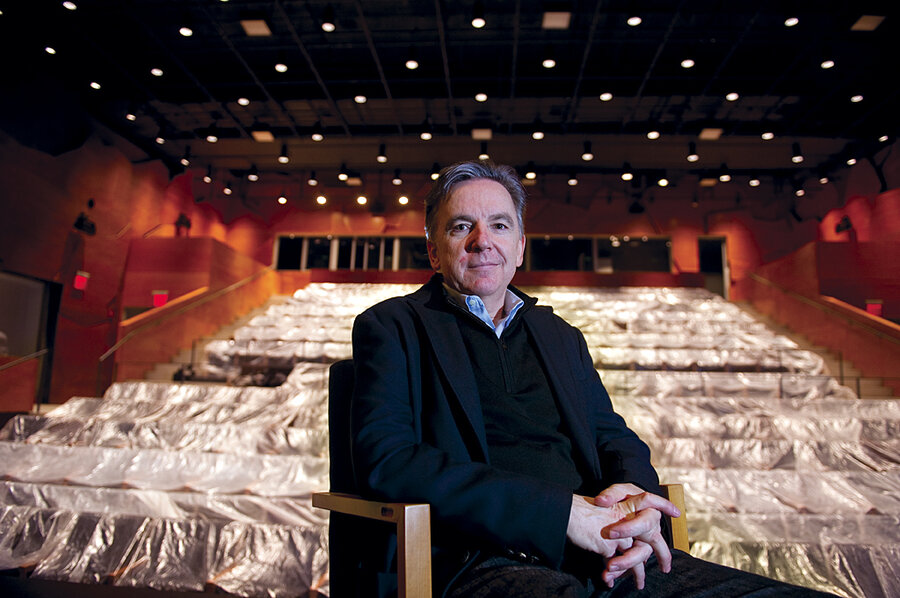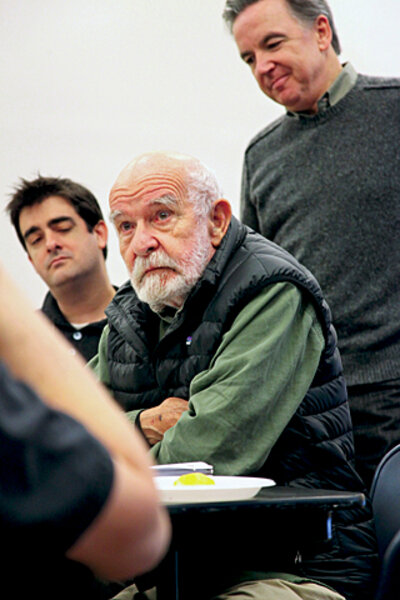Theater for the 99%
Loading...
| New York
When the lights go down at the Signature Theatre Center Jan. 31, the curtain won't just rise on a performance of Athol Fugard's classic play "Blood Knot." It will also reveal a new era for a small-scale theater with large-scale ambitions.
After 20 years in limited space, this season heralds "an enormous threshold moment," says artistic director James Houghton. It marks the debut of the Signature Theatre Company's new home, a Frank Gehry-designed complex sprawling over a city block on West 42nd Street. "Now we have a home that serves the breadth of our deep vision," Mr. Houghton says, "one place where we can do it all – encourage and honor writers and build bodies of work."
The company, founded by Houghton in 1991, first performed in a tiny 79-seat space, and occupies a unique niche among off-Broadway, nonprofit theaters. "There's no other theater quite like it," says Emily Mann, a director, playwright, and artistic director of Princeton University's McCarter Theatre Center. Its mission is to devote each season to work by a single, living playwright rather than, as Pulitzer Prize-winning playwright Tony Kushner says, "immediately lunging for whatever's new and shiny."
Houghton's mantra is "the thea-ter begins with the written word," and his company spotlights a playwright's entire oeuvre. Last season, which presented both old and new work by Mr. Kushner, "was a stunning experience," the playwright says. "It's like you're taking a look at your life's work ... literally like a time trip."
Actor Edward Norton, who got his start performing in Edward Albee's "Fragments" during the 1993-94 season, has led the fundraising drive for the $66 million, 70,000-square-foot project. When Signature did its Albee season, the Pulitzer Prize winner hadn't had a play produced in New York in 10 years. That is why, when Houghton identified the task of exploring bodies of work – a sort of retrospective for drama – "he hit on a mission," Mr. Norton says, "that was actually necessary."
The tendency to downgrade writers after a box-office flop has left many esteemed authors in the cold. Not only Mr. Albee but also giants of the American theater such as Horton Foote and Tennessee Williams were neglected after their first buzz of success.
Kushner recalls how leading critics "sort of sniffed at" Arthur Miller's new plays, which he was still writing at age 87 and which Kushner terms "really interesting, very viable plays."
As Willy Loman's wife so ringingly declared in Mr. Miller's iconic "Death of a Salesman," "Attention must be paid." Signature pays respectful attention not just to greatest hits but also to an author's whole output, which achieves, according to Kushner, "a valorization of the art form" as literature that "can bear up to serious, sustained scrutiny."
"The nice thing about Signature is it proves you're not only as good as your most recent play," Albee says. "You're as good as the entire corpus of your work."
From the beginning, the honor of being celebrated attracted major dramatists like Miller, Mr. Foote, Sam Shepard, John Guare, Lanford Wilson, and August Wilson, which provided momentum and built devoted audiences.
Signature also distinguished itself by involving playwrights in every aspect of production. "A lot of people think the director knows more about the play than the playwright, which is preposterous nonsense," Albee says. "I have this bizarre notion that nobody knows better what the play is about and how it should sound and look than the person who wrote it." A self-described "control freak," Albee immerses himself in details like set design and lighting to craft definitive productions. His play "The Lady from Dubuque" opens at Signature Feb. 14.
With the enlarged center (three theaters seating a total of almost 700 patrons), the Signature can now expand its mission. In addition to focusing on the historical canon, Houghton is launching a program called Residency 5, which will pay a stipend of $50,000 to five young playwrights and guarantee them three productions over the course of five years. The African-American playwright Katori Hall (whose "The Mountaintop" won London's Olivier award for Best New Play and is now on Broadway) is rehearsing her play "Hurt Village," which opens at the Signature Feb. 7. [Editor's note: The original version incorrectly stated the title of Katori Hall's play 'Hurt Village.']
"Signature is really moving American theater forward in saying there are young voices and new stories that need to be heard," Ms. Hall says. "Otherwise, these stories will never be produced or sometimes never even be written."
Hall called the center her new artistic home, saying, "It's more than dating; it's a marriage. We're committed to having three children together."
Pulitzer Prize finalist Will Eno is a young playwright who'll have a new play ("Title and Deed") première this spring. Residency 5, he said, "is specifically and aggressively in the direction of new work, a deepening and widening of the original Signature idea."
Mr. Eno praises Signature's pledge to sell all tickets for the next 10 years for only $25. "It's a very shrewd move on Signature's part but also a very loving and decent gesture."
"Everyone's afraid of what commercial theater pricing will do to the theater," Norton says. With tickets for Broadway shows selling for more than $100 per seat (and a recent Broadway League survey showing the average income of theatergoers is $244,000), "We're pricing ourselves out of our next generation," Norton says.
"Access for all is where it all begins," Houghton affirms. Since the Signature began selling every ticket for $20 in 2005, "we aren't fighting to get people in," Norton says. "People are fighting to get in." Democratizing the theater experience has lured audiences that are younger and more ethnically and economically diverse. In 2009, when most theaters in the United States were only 60 percent occupied, Signature's seats were 100 percent full.
Ms. Mann called the affordable-ticket initiative "imperative," saying, "Most of the great plays being written are not just for the 1 percent. Often the people one wants to reach are the middle class and the working-class folks or students or young people." Making theater accessible cultivates "not only the next generation of theatergoers," she says, "but the next generation of theatermakers."
Signature leaders hope the initiative will become a workable business model for other institutions "to attract and galvanize different kinds of audiences," says Kate Levin, New York's commissioner of cultural affairs, which could "have a meaningful ripple effect for the arts in general."
"The key to the entire center," Houghton says, "is to create communication and community," a sort of village green for exchange of ideas. This is where Mr. Gehry's design is crucial, with 10 percent of its footprint devoted to a vast, loftlike lobby envisioned as a crossroads for mingling before or after a show. Houghton calls it "putting backstage center stage," with the lobby a venue for collisions between writers, actors, directors, and audience.
"I wanted to create a space," Gehry says, "that celebrates and enhances the intimacy between the performer and the audience," an interaction he calls "palpable" in a live performance.
The new center is no flamboyant Guggenheim-Bilbao – the expressionistic museum where Gehry unleashed his Baroque imagination. Adhering to a stringent budget, Gehry used stained plywood panels on theater walls in a cracked-earth motif, as if to suggest the vital juice is on stage and in the audience. Yet the theaters and spacious lobby and staircase create a dramatic atmosphere that gets the adrenalin flowing, an interior as energizing as the activity it holds.
"People are beginning to buy special experiences," Mann explains, where they seek connection and depth of involvement. "Thank goodness," she adds, "because it can't all be 'Gee, how many helicopters can fall from the ceiling?'"
Ms. Levin agrees, noting a trend away from bland, utilitarian theaters concerned more with crowd control than hospitality. Design that elevates the experience and offers an opportunity to congregate and continue the conversation creates, she says, "meaningful public space."
Norton describes the center as a grass-roots artopia, with master playwrights mentoring younger aspirants and all engaged in outreach to the community through readings or Q-and-A discussions, producing "a very fertile cross-pollination." He hopes the result is "a buzzing community of artistic ferment," an artist colony "like you fantasize about when you get into the arts."
Given the preponderance of frothy, recycled musicals, revivals, star vehicles, and spectacle-laden knockoffs of movies or cartoons on Broadway, one often hears the complaint that theater is dead. "The theater's no more dead than air," Houghton counters. "The theater is life."
"We don't go to the theater just to be entertained," Norton says. "We go looking for meaning, insights in how to understand our lives and our society and our place in the world better, to get outside the echo chamber of our own narrow experience and be expanded."
"I have no worries the theater will disappear," Eno says. He sees the new Signature as a place "to hear things and feel things and think things," helping him to "potentially become a larger and better person."






